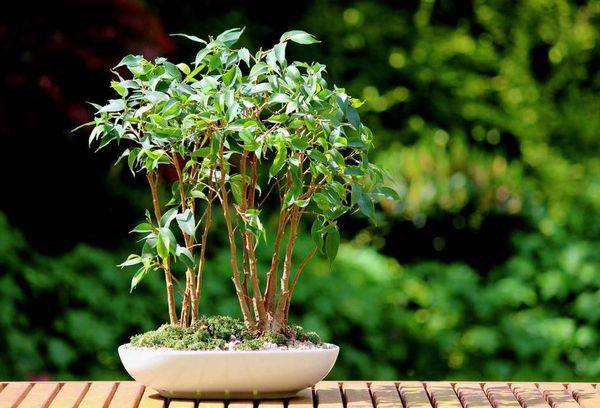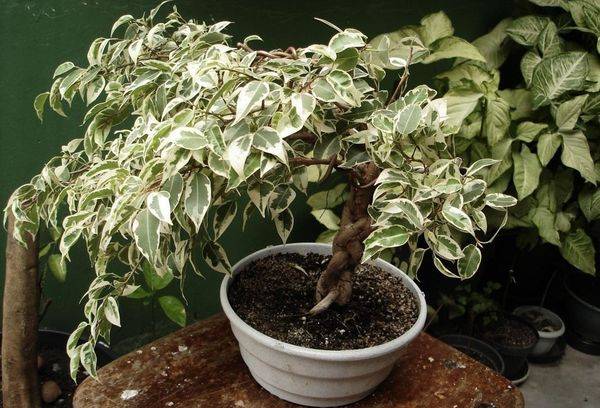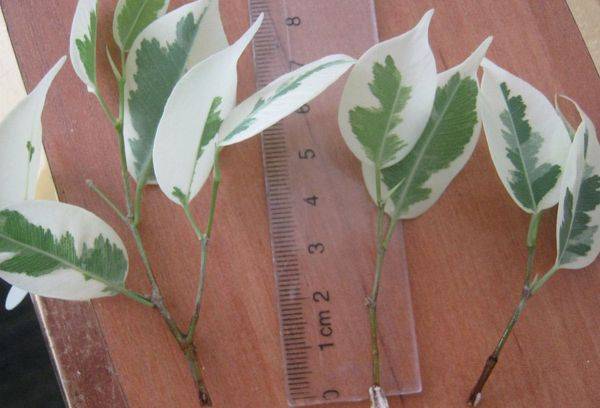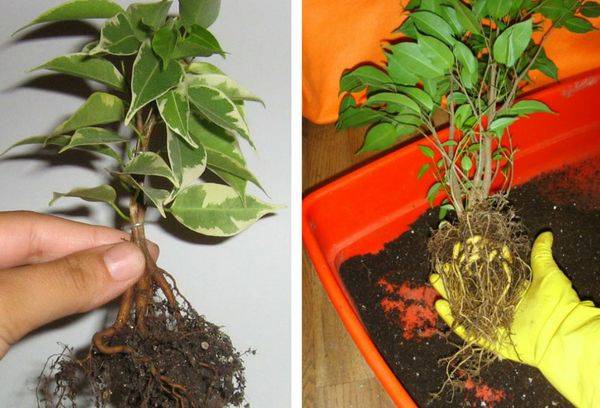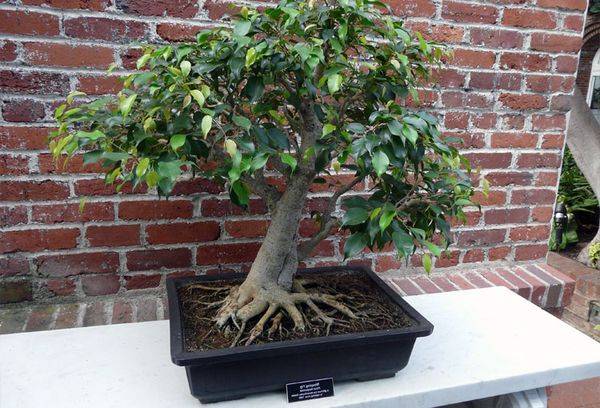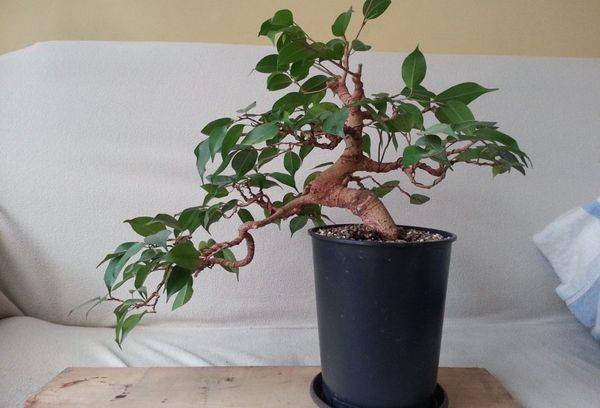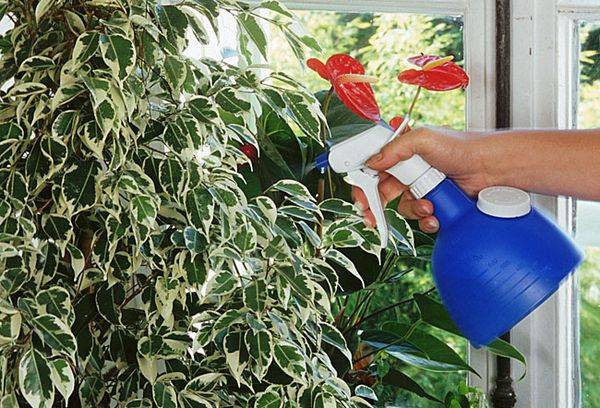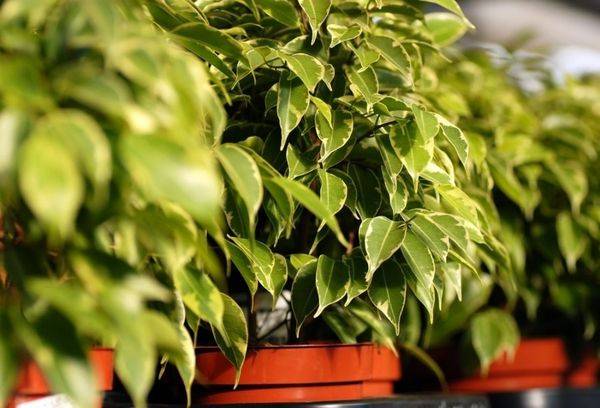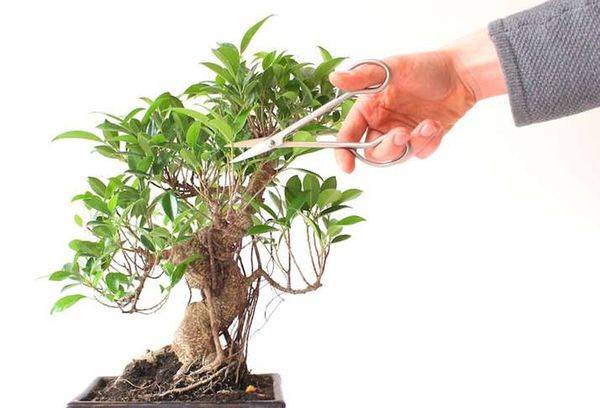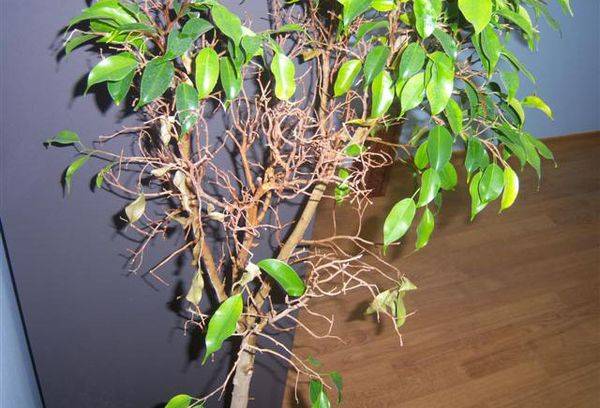How to grow Benjamin's beautiful ficus at home
Content:
The birthplace of ficus Benjamin are countries with a tropical climate: Philippines, India, China. In the climatic conditions of Russia, Benjamin's ficus is a home flower. The plant is rather unpretentious in the care, but there are subtleties and nuances, the knowledge of which will help the owners in the care, and the flower will develop normally, pleasing health and amazing beauty.
There are many varieties with leaves of different sizes, colors and shapes. Popular among Russian flower growers: Danielle, Exotica, Monique, Barok, variegated Starlight and Reginald, small-leaved Natasja, Kinky, Wiandi. Dwarf varieties are used for bonsai.
Plant description
In the wild, Ficus Benjamina reaches 25 meters in height, in the apartment - no more than three. This is an evergreen perennial with a developed root system. In this case, the roots are quite fragile, which must be taken into account when replanting a plant.
A flower makes its foliage decorative, which can be variegated or plain. Ficus leaves with a delightful glossy overflow, very smooth, depending on the variety, they grow in length from 4 to 12 cm, in width - from 3 to 6 cm. They are arranged on the stem alternately and form in one plane.
Ficus Benjamin has a gray bark with rare brown streaks in the form of strokes, a wide crown and drooping branches. The fruits of the plant are orange or red, they are distinguished by an oblong or round shape, paired, approximately 2 cm in diameter. They can not be eaten.
The flower fits perfectly and decorates any interior, therefore it has gained wide distribution in phytodesign, indoor floriculture, landscaping.
Reproduction and planting
At home, Benjamin's ficus is propagated by cuttings, and March-April is the best time for this.
Tip
Scissors cannot be used for cutting cuttings, since the blades squeeze the twig when cutting, which is why the bark partially peels off. It slows down rooting.
How to propagate a flower:
- Secateurs cut cuttings from 10 to 20 cm long from lignified adult branches. Immature green cuttings cannot be rooted, as they decay and die from prolonged exposure to water or substrate.
- Rinse the protruding milky juice with warm water or remove it with a soft cloth.
- Cut the cuttings along the stem with a very sharp knife, separate the formed parts with toothpicks or matches. This technique will stimulate the formation of roots.
- Place the cuttings in water, peat tablets or a substrate. In the water used for rooting, add 1 tablet of activated carbon and often replace the solution with fresh. To prepare the substrate, take an equal amount of sand, sheet and turf soil or peat and chopped charcoal.
- purityis.decorexpro.com/en/ recommends that in order to stimulate root formation, add succinic acid or 1 tablet of “Kornevin” to 1 liter of water and soak in a solution of cuttings for 12-20 hours.
- The roots will appear 2-4 weeks after propagation by cuttings, if the air temperature is 20 ° C and above. To speed up the process, organize a greenhouse or cover the cuttings with a large plastic bag.
- After the roots grow a few centimeters, transplant them into permanent soil.
- In the first weeks, cover the seedlings with a bag until leaflets appear on the plant.
Transfer
Transplant young ficus every spring, adult plants - once every 2-3 years. Carefully transfer the flower into a large pot, as its root system is fragile. The first 2 weeks after transplantation, the plant may fall leaves. Every year, change the topsoil to a fresh one for the tenants.
You can not transfer the purchased ficus from the transport pot to another immediately. For a plant, a change of location is stressful; it must adapt to the microclimate of the room. Therefore, transplant purchased ficus only after 2-3 weeks.
When you need to do a transplant:
- the soil of the transportation pot is not suitable for continuous plant growth, so it must be transplanted;
- if roots come out of the drainage hole, this indicates that the pot is small for the flower;
- when the soil is affected by pathogens or fungus.
It is necessary to transplant Benjamin's ficus for the first 4 years of life every year, starting from the age of five - once every 2-3 years. Between transplants, renew the topsoil in the pot.
Handling Rules:
- The new transplanted pot must be 3 cm taller than its predecessor.
- The optimal soil for cultivation is leafy and should have neutral acidity (pH). Flower shops sell special soil for ficus.
- Be sure to lay a layer of drainage on the bottom of the pot.
- Do not clear the roots of the earth when transplanting, as they are very fragile and the slightest damage will affect the growth of the flower. Use transshipment.
- Water the plant after transplanting no earlier than two days later.
Lighting
The growth and development of ficus depends on how good the lighting in the room will be. Insufficient amount of light, especially for varieties with variegated leaves, will lead to the fact that the flower will gradually lose its decorative effect and its growth will slow down.
Excessive lighting is also undesirable, as it can cause yellowing of the leaves and the occurrence of burns on them.
If there is a lack of sunlight in the winter months, perform illumination with phytolamps. In the summer, place a flower pot on the balcony, loggia or window sill located on the east, southeast or west side of the house. On hot days, it is better to put Benjamin's ficus in partial shade in the open air.
Tip
Do not rearrange the pot with the plant too often. This can trigger a drop of leaves.
Temperature
In summer, it is better to keep Benjamin's ficus on the street, but if the temperature drops to + 15 ° C, bring the flower into the house. Inappropriate temperature conditions, if the room is too cold, will provoke leaf fall. The optimum temperature is from +18 to + 30 ° C. In the room where the flower grows, drafts are unacceptable.
Priming
The soil for growing Benjamin's ficus should be moisture permeable, fertile, with a high degree of aeration. Acidity - slightly acidic or neutral (pH 5.5-6.5). The composition of soils purchased in a flower shop varies depending on the manufacturer. The main components in them are peat, sand, complex fertilizers, humus, expanded clay. If you buy universal soil and add the same amount of turf and leaf soil to it, you will get excellent soil for Benjamin's ficus.
Humidity and watering
In the summer months, spray the crown with boiled water, since after the usual with high rigidity, whitish stains will remain on the leaves. Excessive watering of ficus Benjamin is unacceptable.
Watering is the main component of plant care and depends on the individual characteristics of the flower and growing conditions. How often you need to water depends on the season, humidity, age of ficus, temperature in the room and lighting.
In summer, focus on the degree of drying of the earthen coma - the soil should be dry at a depth of 2-3 cm.In winter, reduce the number of irrigations, but do not allow the land to completely dry out.
Tip
The pot should have drainage holes through which excess moisture will flow, drain the water from the pan.
Pour ficus with settled or boiled water, which should have room temperature. Once every 3 weeks, arrange a "tropical shower" for the flower. Place the plant in a bathtub, cover with plastic wrap on top and pour over it for several minutes with a warm stream of water. Do not take the plant out of the bathroom immediately, as it may become too cold due to sudden temperature changes.
Fertilizers and fertilizers
Once every 2 weeks in spring and summer, feed Benjamin's ficus with universal fertilizers designed specifically for ficus or ornamental and medicinal plants. For example, the Agricola complex, REASIL, Pokon or Bona forte.
When choosing a mixture, consider the amount of nitrogen contained in it, which should be higher for top dressing in spring and summer and lower in the winter months.
Starting in September and ending in March, feeding ficus is not recommended.
In March and April, feed the flower once a month, in May - once every 3 weeks, in the summer - once every 2 weeks. For feeding, not only universal mixtures purchased in a flower shop, but also bird droppings, ash, sapropel are suitable.
Pruning
In order for a beautiful fluffy crown to form, periodic ficus pruning is necessary - in spring and summer. Old plants need a rejuvenating haircut, thanks to it new young shoots grow from axillary buds. You need to trim the branches depending on which crown you want to get, but no more than a third.
Thin out the crown inside the plant, thanks to this, the leaves will receive a sufficient amount of light.
Tip
To make the plant unusual and give it a more attractive appearance, put several ficuses in one pot, twist their trunks into bundles or weave them in braids using trellises and clamps.
Why do the leaves of ficus Benjamin turn yellow
The leaves of the plant turn yellow for several reasons:
- due to waterlogging of the soil with excessive irrigation and stagnation of water;
- insufficient watering and severe drying of the earthen coma;
- with damage by spider mites;
- young leaves turn yellow when there is not enough iron in the soil (feed the plant “Iron Chelate” or “Ferroovit”);
- with a lack of moisture in the air and temperature extremes;
- watering immediately after transplantation (you need to wait 2 days after planting, and only then moisturize);
- with an incorrectly sized pot (it is very large or too small, and the flower in it is crowded);
- if the ficus planted in the wrong soil or poor quality soil;
- with damage by pathogens.
Useful Tips
The main rule of how to care for Benjamin's ficus is transplantation, pruning, planting, top dressing begin in early spring, when the sun begins to actively warm. Most often, the appearance of the plant reflects errors in care:
- Drafts, changes in location, temperature changes, insufficient lighting, cold watering, untimely transplantation - the reasons why the leaves begin to fall off.
- Waterlogging of the soil provokes the formation of dropsy - growths on the underside of the leaves. To eliminate the problem, adjust the watering mode.
- Excess fertilizers, inadequate humidity and intense heat are reflected on the tips and edges of the leaf blades - they become brown in color. Spraying the crown of the flower and airing the room where the ficus grows, but without drafts, will help to eliminate the trouble.
- Nutrient deficiency leads to slow plant growth and the formation of small new leaves. If the flower is greatly weakened, then feed it with a half dose of fertilizers, from the one recommended by the manufacturer on the package.Fertilizing the mass will help to fertilize with fertilizers with a high nitrogen content or infusion of mullein (to cook it, pour 1 part of cow manure with 10 parts of water).
- Excess nitrogen in the winter is manifested in the form of weak shoots and deformed leaves. Stop feeding ficus and provide the flower with sufficient illumination by putting it to the window or using a phytolamp.
- The plant looks wilted with a moist soil coma when the root system is affected by rot. Excess moisture and low soil temperature provoke the emergence and development of root rot. It is useless to treat ficus from this scourge; destroy it along with the soil.
- If pale dots appear on the leaves, this indicates an invasion of spider mites. Similar traces remain after their bites, in addition, a spider web appears on the ficus, the leaves turn yellow and fall off. The reproduction of ticks contributes to insufficient (low) humidity and high temperature. To destroy ticks, use acaricides, for example, Vermitek, Fitoverm, Sunmayt, Actellik. How to use them correctly is indicated in the instructions.
- Benjamin's ficus is often affected by scabies, which usually live on the trunk and underside of leaflets. Parasites in the process of life release a specific juice, a sooty fungus settles on it. Wipe off insects with a swab soaked in alcohol, then spray the Aktara plant in accordance with the instructions for use. After 7 days, re-treat, but with another insecticidal agent - “Commander” or “Confidor”.
- The whitish surface of the leaves indicates the onset of thrips, whose adults lay eggs on the underside of the leaf. Isolate the affected flower and treat it with insecticides. You can apply the following: “Aktara”, “Morspilan”, “Vermitek”, “Spark”.
- High humidity and temperature provoke the occurrence of a disease called gray rot. The affected areas of the flower are covered with gray mold, gradually darken and die. Reduce watering, remove the diseased parts of the ficus.
- If spots of dark brown color appeared on the leaves, which gradually merge and increase in size, this indicates the defeat of the plant by anthrocnosis. The causative agent of the disease is a fungus that causes the death of the flower. Remove infected leaflets and spray ficus with fungicide (Fitosporin, Rival). Ventilate the room in which the plant is often and reduce the amount of watering.
Ficus Benjamin is a beautiful and noble flower, it is not too capricious, and yet requires some care. Take care of the green pet correctly, and it will delight you and your guests with shiny leaves and a lush crown.
